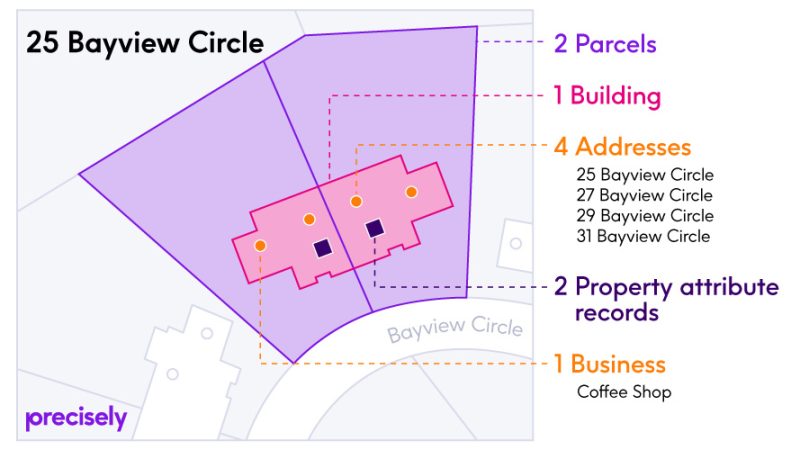When a property is central to business decisions, data enrichment becomes critical to success by providing a 360-degree view of the factors that influence those decisions. The reality is, most businesses have limited property data in-house, often just an address, which means they depend on third-party data providers like Precisely to fill in the gaps.
In an ideal situation, that address will relate to one building, situated on one piece of taxable land, that is all owned by a single individual. In the real world, however, the relationship of property features, characteristics, and ownership is often much more complicated and difficult for companies to discern.
Precisely built Property Graph to make it easy for customers to accurately represent complex real-world scenarios by simplifying relationships between Precisely address, property, and points of interest data products. Here’s how Property Graph and these products work together to enhance property data enrichment.
1. Simplifying Complicated Connections Between Property Features

When multiple addresses are associated with one parcel, for example, or two parcels with one building, understanding these relationships can be challenging, especially when implementing automated processes. This can also be the case using Precisely data, where we have assigned each address, parcel, and building with its own unique and persistent identifier. Property Graph uses those persistent identifiers along with relationship classes and types to resolve these complex relationships. To do this, many factors must be considered. Precisely has applied logic to perform multi-tiered spatial analysis to establish relationships between property features, saving our customers time and resources.
Consider a property with one building that sits on a corner with road frontage and addresses on two different streets, or a multi-tenant building situated across multiple parcel boundaries, each with its own property tax record. Property Graph makes it easy to gather all this related information to get a complete view of the property.
2. Bringing Data from Disparate Sources Together in One Place
Property Graph is easily loaded into database management systems along with the data from two or more of the supported Precisely data enrichment products: Precisely Address Fabric, Parcel Boundaries, Buildings, Property Attributes, and Points of Interest datasets. These datasets are curated and normalized for immediate interoperability without any data wrangling on the customer’s part.
Read our eBook
Achieving Data Interoperability
Read our eBook and see how Precisely helps businesses manage and organize data to bring greater location context to their analysis and answer the biggest challenges around data.
3. Enriching Data Analytics and Existing Business Processes
Property Graph is built to support data queries, automated processes, and SaaS applications. Once feature IDs from a related data product are identified, such as the relationship between a PreciselyID, a Building ID, and Parcel ID, they can be used to query the associated attributions in other supported Precisely data products. Companies can also easily integrate Property Graph and enrichment data into current business processes and analytics. For example, telecommunications companies need data to plan and build infrastructure to bring high-speed fixed broadband service to rural homes and small businesses, while insurance companies can understand adjacent and co-tenant risks during the underwriting process.
4. Improving Decision-Making with Trusted Data
People move. Property gets sold. Postal codes change. That’s why we take data integrity seriously at Precisely, so business users, analysts, and data scientists can focus on solving business problems. Property Graph and Precisely data products are carefully sourced, correct, complete, and current, with published update schedules. Property Graph itself has been thoroughly cleaned to remove “background noise” and to ensure correct relationships so users can make business decisions with confidence.
Property Graph, combined with detailed and accurate enrichment data, has a significant value to telecommunications, insurance, PropTech, and other industries that rely on property-related business decisions. Explore the value of property data enrichment with Property Graph.
Read our eBook Achieving Data Interoperability and see how Precisely helps businesses manage and organize data to bring greater location context to their analysis and answer the biggest challenges around data.







